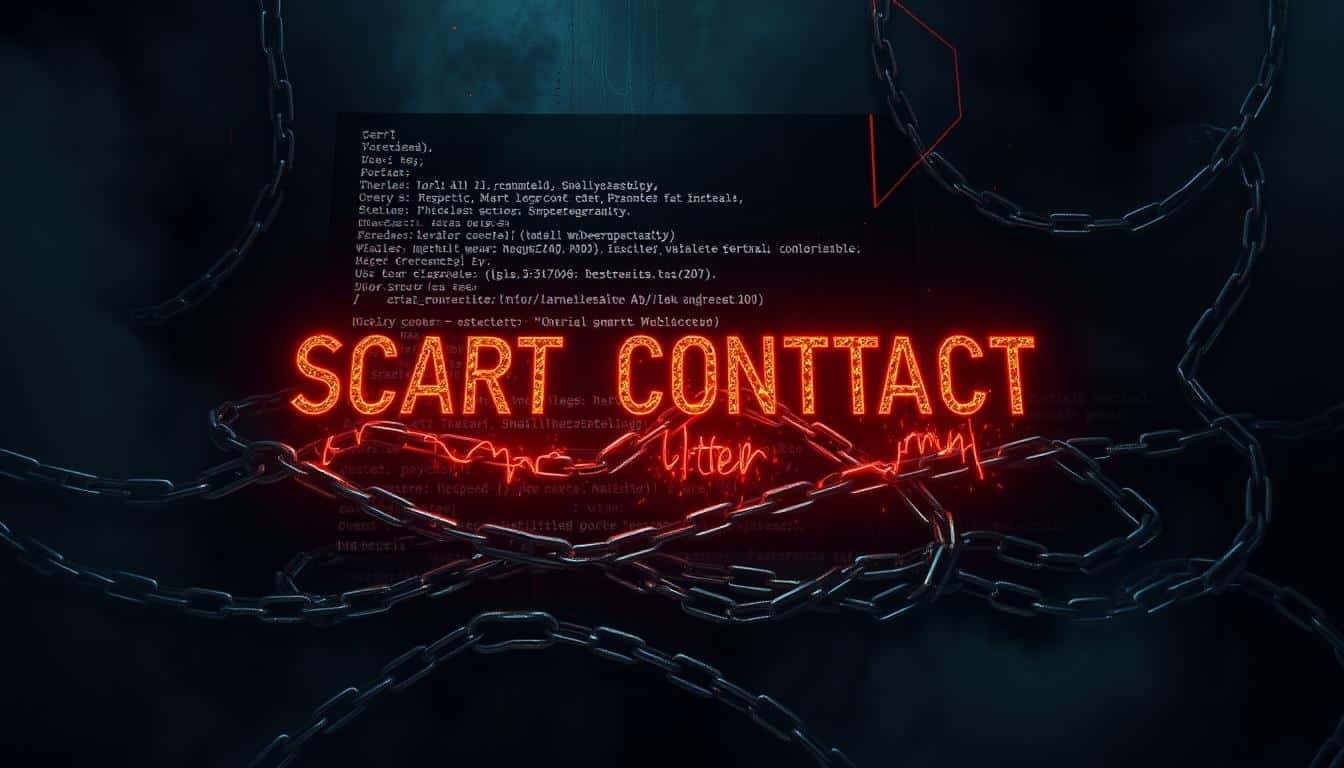The Dark Side of Smart Contracts: Hidden Truths
Did you know nearly 80% of smart contracts have flaws? These flaws could cause big money problems. This fact shows the dark side of smart contracts, which are more and more used in decentralized apps and finance. They are meant to make things automatic and efficient. Yet, many people don’t see the hidden risks of smart contracts. They think everything is great when it’s actually complex. You could run into problems that risk your cryptocurrency or business.
We want to show you the smart contracts security issues that people often miss. There are dangers and risks that could be huge disasters. It’s also about understanding the effects on decentralized finance and rules. Knowing these things is key to doing well in this area. Let’s discover the truths that everyone using smart contracts should know.
Key Takeaways
- Smart contracts are more popular but not well understood.
- Flaws in smart contracts can cause big financial losses.
- People’s views on automation might hide the real dangers.
- Knowing about security issues is crucial for using smart contracts well.
- Rules and watching over will be big for smart contracts’ future.
The Rise of Smart Contracts
Smart contracts are changing how we do business in many areas. These contracts run on set rules and do not need middlemen, making things more direct thanks to blockchain. This shift to smart contracts offers benefits like better efficiency and more clarity.
In finance, real estate, and supply management, companies are turning to smart contracts for smoother operations. These digital tools offer more visibility and trust, fixing old issues that made contract signings difficult. This shows how innovative smart contracts are in reshaping business practices.
Smart contracts are now doing more than just sealing deals. They let organizations automate complicated tasks, cutting down on errors and wait times. This progress shows smart contracts are a key development in managing agreements, not just a passing phase.
“The future of transactions is autonomous, embedded within the code of smart contracts.”
| Industry | Potential Benefits | Use Cases |
|---|---|---|
| Finance | Faster transactions, reduced costs | Trading, settlements |
| Real Estate | Transparency, reduced fraud | Property sales, leasing |
| Supply Chain | Efficiency, traceability | Logistics tracking, inventory management |
Smart contracts are proving themselves across different sectors by not just their ability, but also by transforming how things work. As blockchain technology keeps evolving, the promise of decentralized apps is just beginning to unfold. Understanding the role of smart contracts is key to grasping the changes in future business trends.
Understanding Blockchain Technology
The core of blockchain technology is its decentralized setup. It uses distributed ledgers for secure, transparent transactions without middlemen. Grasping blockchain is key to seeing its impact on finance, supply chains, and identity management.
At its heart, how blockchain works is built on nodes. They keep exact data copies for high security. Each record is cryptographically sealed, securing data integrity. This also makes the data unchangeable once recorded.
The consensus mechanism is a big part of blockchain. Nodes use methods like Proof of Work or Proof of Stake to validate and add transactions. This agreement builds trust and cuts out central authorities.
Blockchain’s clear nature is attractive. Everyone can see transaction histories for more accountability. Smart contracts thrive here, automating deals and cutting costs and time.
Blockchain goes beyond just cryptocurrencies. Many industries are using it to boost efficiency, track goods, and secure data. Its promise is reshaping business models and sparking new solutions.
Recent data give us insights into blockchain market trends. TON Blockchain’s Toncoin, for example, is around $5.215. If it stays above $4.997, it could jump to $5.981. This shows blockchain assets’ volatile nature2.
Tools and platforms are evolving to better crypto trading and investing. Keeping up with these changes helps you make the most of the blockchain landscape.
“Understanding blockchain technology enhances your ability to leverage its capabilities effectively.”
Keep exploring blockchain’s different aspects as it influences more industries.
The Dark Side of Smart Contracts: What No One Tells You
Smart contracts bring many benefits, but they also have a dark side. Hidden risks often go unnoticed. It’s key for anyone diving into this tech to understand these downsides.
Unforeseen Vulnerabilities
Mistakes in coding smart contracts can lead to big problems. Even small errors can be exploited. This puts projects in danger, which is a part people often miss. Developers need to be very careful when coding to avoid these issues.
Smart Contracts Risks
Smart contracts can face technical issues. These risks might cause errors or even make you lose money. The need for testing and auditing is crucial to prevent such problems. Skipping these steps could have serious consequences.
What Happens When Code Fails
Code failure in smart contracts can lead to serious problems. Not just financial loss, but it can also hurt reputations. Looking at past incidents reminds us of the risks. Staying informed and careful is the best way to deal with these challenges.
Decentralized Finance Dangers
The world of decentralized finance (DeFi) is filled with challenges, especially when dealing with smart contracts. Knowing the decentralized finance dangers is key. This is because issues like liquidity mismatches and price changes can hurt your investment returns. They could even lead to big money losses.
One main DeFi risk comes from the liquidity problems of many platforms. In a decentralized setting, not having enough liquidity can cause big price jumps. This can mean big losses. It might be tough for users to sell their assets at a good price if the market suddenly changes.
Additionally, risks associated with smart contracts include hacks that search for weak spots in these digital contracts. If bad actors find and use these flaws, it can result in serious issues. It’s important to have strong security because users’ funds are usually pooled together. Thus, if there’s a hack, it could hurt a lot of investors.
To wrap it up, diving into DeFi without knowing the risks can put you in a risky spot. Being aware and careful about these dangers is vital when you’re participating in decentralized financial systems.
Cybersecurity Threats in Smart Contracts
The world of smart contracts is facing more cybersecurity threats lately. These dangers mainly come from hacking vulnerabilities in smart contracts. These weaknesses can cause big financial losses and damage to the reputation of companies. Understanding these vulnerabilities is key to protecting against hackers.
Hacking Vulnerabilities
Hackers have many ways to attack smart contracts. In the last five years, phishing has become the top method for cyberattacks on blockchain. Despite strong security steps like two-factor authentication, these risks are still a big problem. This shows the ongoing need for better blockchain security.
Security for endpoints has gotten better, offering more defense against malware3. But companies must stay alert. No security system is perfect. Good management and solid defense layers are crucial. They help close the weaknesses that hackers look for.
Case Studies of Smart Contract Failures
Some real incidents show the severe effects of poor security. These events highlight the big failures in smart contracts. To avoid such problems, creating a specific threat model is advised. This helps focus on the most important blockchain security threats4.
The lessons from these incidents stress the importance of being proactive. Limiting app installation and detailed software logging are must-dos to protect systems.
Flaws in Blockchain Smart Contracts
Blockchain smart contracts can face many challenges. One big problem is the complexity of contract logic. Complex codes can lead to unexpected results. For example, a small mistake in the code could have major financial effects. This shows why designing these systems carefully is very important.
Another issue is the lack of strong governance mechanisms. This weak framework can expose smart contracts to risks. Without good decision-making structures, it’s hard to adjust to new laws or situations. This can make the blockchain seem less reliable and trustworthy.
Moreover, smart contracts can struggle to adapt when laws change. This stiffness may cause legal confusion. Users might not be sure of their rights. You can learn more about these issues here.
The problems with smart contracts highlight the need for thorough testing and validation. Knowing about these issues helps everyone involved. This can make the implementation smoother and lower the risks. It’s important for the community to keep learning and adapting to these challenges.
Understanding these problems is vital, not just in theory. Knowing about these blockchain issues can prevent serious disruptions. It’s crucial to use best practices from both technical and regulatory sides45.
The Impact of Regulatory Oversight
Regulatory oversight is key in how smart contracts are used across different sectors. As smart contract tech grows, it’s vital to grasp how complex laws shape their use and enforcement. Challenges often arise from unclear regulations, affecting the blockchain world.
Understanding the legal side of smart contracts is crucial. Though this technology is growing fast, varying laws can be obstacles for companies trying to use smart contracts. This can slow down innovation and discourage investments, affecting the market’s expansion.
It’s important to know how laws can impact the validity of smart contracts. Different places might see terms and obligations differently, causing disputes and trust issues. Clear, consistent laws are needed to build a strong future for smart contracts.
The rise of blockchain tech means we must work together to create suitable laws. Addressing these gaps can make smart contracts more than just efficient—they’ll be legally solid, too. This could help build a stronger digital economy.
| Regulatory Challenges | Potential Solutions |
|---|---|
| Inconsistent regulations across jurisdictions | Developing harmonized regulatory frameworks |
| Ambiguity in legal recognition | Establish clear guidelines for smart contract implementation |
| Enforcement issues in disputes | Creating dispute resolution mechanisms |
| Compliance costs | Offering incentives for compliance with regulations |
Effective oversight makes smart contracts more reliable and trusted in various fields. By promoting a good regulatory setting, we can unlock the full potential of this changing technology67.
The Future of Smart Contracts Security Issues
The future of smart contracts is closely tied to solving smart contracts security issues. As tech moves forward, tools for automated checking are more common. These tools help find problems before they become serious. Adding formal checks to smart contracts is key for making them reliable.
Many apps that work on their own are using these methods to handle the evolving risks in smart contracts. This way, they reduce harm from mistakes in the code. Also, new rules from authorities might change how smart contracts are made and used.
- Emerging technologies for enhancing smart contract security
- Importance of automated auditing tools
- Potential impact of regulatory advancements
Those investing and developing need to stay alert as things keep changing. Knowing about the future of smart contracts helps them deal with new tech and security issues. Learning more about these areas helps them make smart choices.
| Technology | Purpose | Benefits |
|---|---|---|
| Automated Auditing Tools | Identify vulnerabilities | Cost-effective error detection |
| Formal Verification | Ensure code reliability | Enhances trustworthiness |
| Regulatory Frameworks | Set operational standards | Promotes security compliance |
Understanding these trends equips stakeholders to handle the tricky issues around smart contracts security issues ahead. This ensures the safety and trust in their digital deals1.
Conclusion
As we conclude our look at smart contracts, it’s essential to recognize the risks they bring. We’ve seen that these contracts come with dangers that need careful attention. To stay safe, focus on good coding, security checks, and knowing the law is crucial.
Talking about smart contracts, being cautious is key. The chance to earn more might seem appealing, as shown by blockchain projects like Qubetics. But the risks linked to smart contracts should not be ignored. Investors and creators must stay alert and use these technologies wisely.
The shift towards decentralized finance and blockchain is fast. Making security, legal compliance, and learning a priority will help build trust in smart contracts. It’s about knowing both the good and the bad. This will help keep a well-rounded view as we move forward82.








 Bitcoin
Bitcoin  Ethereum
Ethereum  Tether
Tether  XRP
XRP  Solana
Solana  USDC
USDC  TRON
TRON  Lido Staked Ether
Lido Staked Ether  Dogecoin
Dogecoin  Figure Heloc
Figure Heloc  Cardano
Cardano  Wrapped stETH
Wrapped stETH  Bitcoin Cash
Bitcoin Cash  Monero
Monero  WhiteBIT Coin
WhiteBIT Coin  Wrapped Bitcoin
Wrapped Bitcoin  Wrapped eETH
Wrapped eETH  USDS
USDS  Chainlink
Chainlink  Binance Bridged USDT (BNB Smart Chain)
Binance Bridged USDT (BNB Smart Chain)  LEO Token
LEO Token  WETH
WETH  Stellar
Stellar  Coinbase Wrapped BTC
Coinbase Wrapped BTC  Sui
Sui  Zcash
Zcash  Ethena USDe
Ethena USDe  Avalanche
Avalanche  Litecoin
Litecoin  Hyperliquid
Hyperliquid  Canton
Canton  Shiba Inu
Shiba Inu  Hedera
Hedera  World Liberty Financial
World Liberty Financial  sUSDS
sUSDS  USDT0
USDT0  Dai
Dai  Toncoin
Toncoin  Cronos
Cronos  Ethena Staked USDe
Ethena Staked USDe  PayPal USD
PayPal USD  USD1
USD1  Polkadot
Polkadot  Uniswap
Uniswap  Mantle
Mantle  Rain
Rain  MemeCore
MemeCore  Bittensor
Bittensor